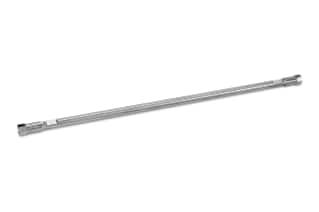
|
Chemistry |
Phenyl |
|
Separation Mode |
Reversed Phase |
|
Particle Substrate |
Silica |
|
pH Range Min |
2 pH |
|
pH Range Max |
8 pH |
|
Maximum Pressure |
6000 psi (415 Bar) |
|
Endcapped |
Yes |
|
Silanol Activity |
High |
|
Particle Shape |
Irregular |
|
Particle Size |
10 µm |
|
Endfitting Type |
Waters |
|
Pore Size |
125 Å |
|
Format |
Column |
|
Surface Area |
330 |
|
System |
HPLC |
|
USP Classification |
L11 |
|
Inner Diameter |
3.9 mm |
|
Length |
300 mm |
|
Carbon Load |
9 % |
|
UNSPSC |
41115709 |
|
Brand |
µBondapak |
|
Product Type |
Columns |
|
Units per Package |
1 pk |

µBondapak Phenyl Column, 125Å, 10 µm, 3.9 mm X 300 mm, 1/pk
The µBondapak Phenyl Columnµ is a general-purpose, silica-based, reversed-phase C18 column that is based on 10 µm particle technology, making it the ideal lab equipment. The column allows both analytical and preparative procedures. When you develop a new purification protocol, the µBondapak Phenyl Column offers the best balance between resolution, throughput, and cost.
If your method calls for µBondapak packings, there is only one µBondapak packing material that is authentic and the leader in the field, the Waters µBondapak Phenyl Column. Many companies claim to have columns with µBondapak-like selectivity but not one has ever passed Waters stringent QC batch test. Waters has set a standard for reproducible, high-performance chromatographic columns which is hard to match. This is why the Waters µBondapak columns are still the most widely referenced and requested columns in the world.
The reversed-phase µBondapak Phenyl Column allows the analysis of particles of irregular shape. The phenyl chemistry of the column means you can conduct these analyses across a wide 2-8pH range. It also offers an operating pressure of up to 6000 psi (415 Bar).
You may also want to explore the µBondapak Phenyl Guard-Pak Insert, 125Å, 10 µm, 10/pk, which enables you to protect your analytical column and ensure its long lifetime. Designed to work especially with the µBondapak Phenyl Column, the Guard-Pak Insert is attached to the analytical column and protects it by removing any chemical and particulate contaminants from the mobile phase.
Check all related products and other variants of the same listing as well as our complete range of products, browse through our catalog. You can also know more about our technology, look up contact details of our various offices around the world as well as shop for lab equipment.
How Should The Column Be Stored?
It is important to remember that leaving the column unused for less than four days does not require any special storage process. For storage of the column for longer than four days, store the column in the shipping solvent, which is identical to the column test solvent. The µBondapak Phenyl Column should be stored in acetonitrile/water. In case the mobile phase contained buffer salt during the analysis, first flush the column with 10 column volumes of 18 megohm water. Do not let the column dry out completely and ensure that the end plugs are firmly in place.